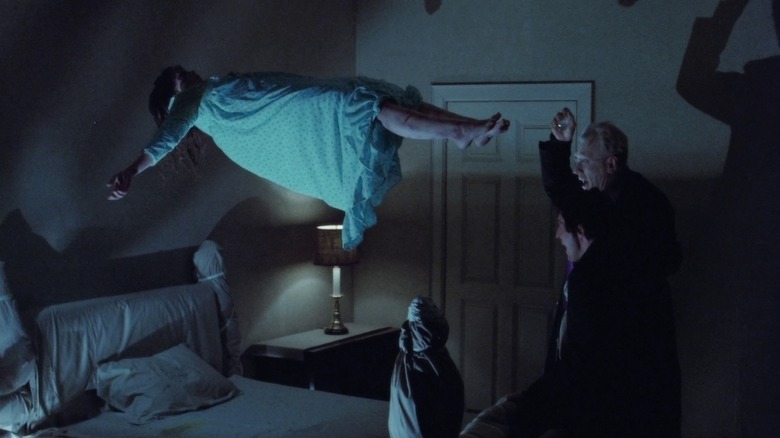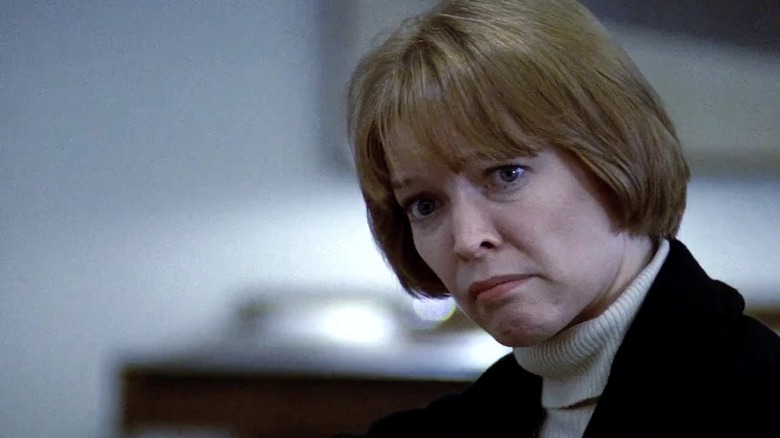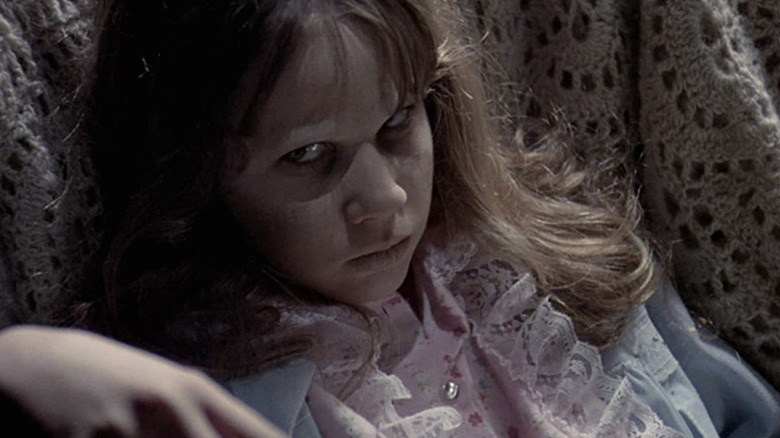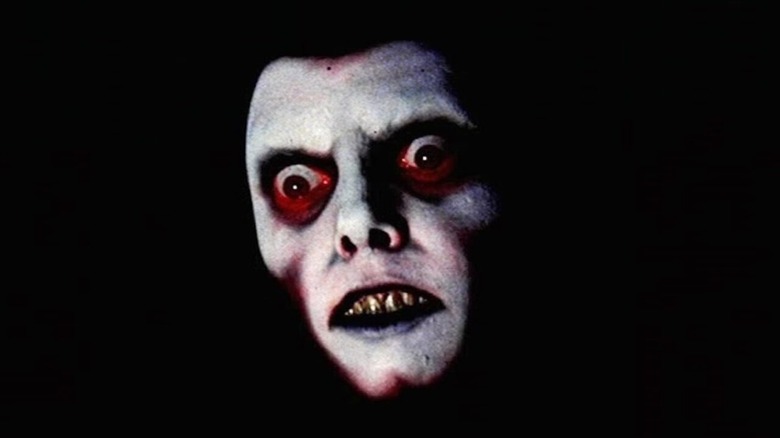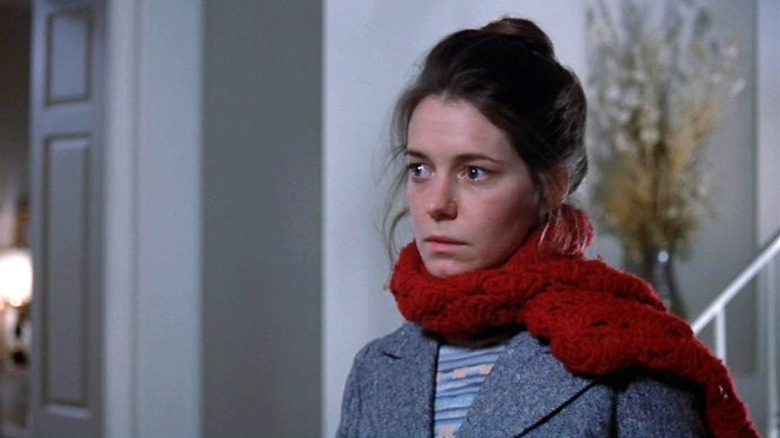The Only Major Actors Still Alive From The Original Exorcist Movie
There's no question that the moviegoing experience has changed since the "The Exorcist" became a landmark cultural event when it was released the day after Christmas in 1973. Anyone that waltzed right in to see "The Exorcist: Believer" in theaters this October would have been shocked by the long lines snaking around the block to see the controversial original when it took the world by storm almost 50 years ago. It's unlikely that any other film will ever match that particular watershed moment in horror ever again.
"The Exorcist" marked the first time a genre film had ever received an Oscar nomination for Best Picture. Notably, the entire production garnered 10 nominations, winning two for Best Adapted Screenplay and Best Sound. In the decades since its release, "The Exorcist" has retained its well-deserved status as one of the scariest movies ever made, having left an indelible mark on generations of unassuming spectators that have bore witness to the demonic terrors taking place inside the cursed bedroom of an innocent teenager named Regan MacNeil.
The ripple effect and worldwide impact that "The Exorcist" created was also felt by the actors involved, who are all now inextricably linked to the horror classic. Sadly, many of the people involved with the film are no longer with us, including the recent passing of legendary director William Friedkin earlier this year. Actor William O'Malley, who played Father Dyer, also passed away in 2023. Max von Sydow and Jason Miller, who both gave such memorable performances as Father Merrin and Father Karas, have, unfortunately, left us too.
Luckily, there are still a number of living links to help continue the long legacy of one of the most frightening movies of all time. Here are all the major actors still alive from "The Exorcist."
Ellen Burstyn
Before being nominated for an Oscar for her role as movie star mom Chris MacNeil in "The Exorcist," Ellen Burstyn was already widely recognized as one of the most gifted actors in Hollywood. For the early part of her career, Burstyn mainly worked in television, proving that the guest appearances on hit shows like "Perry Mason" and "The Virginian" were generally the most interesting parts to play.
In 1970, Burstyn portrayed Henry Miller's wife in Joseph Strick's "Tropic of Cancer" (receiving unanimous critical praise), which she immediately followed up with a heartbreaking turn as an aging mother in a small Texas town in Peter Bogdanovich's "The Last Picture Show." Firmly establishing herself as one of the most talented, emotionally charged performers of the '70s (a decade known for great character work), Burstyn would reach an entirely new level of fame as a desperate mother forced to deal with the demonic possession of her own daughter in "The Exorcist."
With the staggering success of the film, Burstyn found herself in rarified air as an actor of a certain age, yet still had a difficult time finding challenging roles in a Hollywood system that kept churning out stereotypical female characters. After turning down the chance to direct "Alive Doesn't Live Here Anymore," Burstyn was instrumental in bringing Martin Scorsese onto the production (which eventually landed her the Academy Award for Best Actress in 1975).
For the younger generation, Burstyn's dedicated performance as a speed addict in Darren Aronofsky's "Requiem For a Dream" may be her most recognizable role. After turning down multiple sequels to "The Exorcist," Burstyn finally relented and appeared in David Gordon Green's "The Exorcist: Believer." In an interview with The Hollywood Reporter, Burstyn admitted, "I feel like the devil is asking my price."
Linda Blair
Linda Blair was just 14 years old when she played Reagan in "The Exorcist." After the film's release, Blair and her family found themselves mired in controversy and the young teenager also became the focus of a certain amount of public fear. Her performance was so realistic and disturbing that some people may have thought Blair had actually been a true conduit of evil. Blair speaks about her experience in the Shudder docuseries "Cursed Films" and talks about the aftermath of what it was like standing in the wake of such a divisive film — one that went on to receive the ire and condemnation of the Catholic Church.
Blair would eventually return to star in John Boorman's sequel "Exorcist II: The Heretic" four years later on her way to transitioning out of any future roles where she would play the victim. 1984's cult classic "Savage Streets" sees a leather-clad Blair playing a take-no-prisoners vigilante battling a group of sadistic thugs with a switchblade and a crossbow. She would also return to the horror genre, this time as the headstrong daughter of a mechanic who manages to survive a slumber party at a haunted mansion in "Hell Night."
Blair would even go on to lampoon her signature role from "The Exorcist" in "Repossessed" starring Ned Beatty and Leslie Nielsen. After a long and fruitful acting career, Blair continues to appear at horror conventions and has also become a leading animal rights advocate as the President and Founder of the Linda Blair Worldheart Foundation, a non-profit organization dedicated to rescuing and rehabilitating abused, neglected, and abandoned animals.
Eileen Deitz
Born in New York City, Eileen Deitz became the true Face of Death after appearing as Pazuzu aka Captain Howdy in "The Exorcist." Deitz is featured in brief flashes in Friedkin's original version in what looks to be an intentional form of subliminal messaging. The image of the demon was expanded to include a few more shots in "The Exorcist: Director's Cut" after Deitz's indelible face became a much more prominent part of the film's legacy. Deitz was also part of a team of actors that worked with Linda Blair's character, but was never officially a body double for Regan during filming, contrary to popular belief.
Before "The Exorcist," Deitz appeared in the seminal experimental film "David Holtzman's Diary" in 1967 about a young man supposedly chronicling his daily routine wandering around the streets of New York City. It is widely considered to be one of the first mockumentaries in U.S. cinema. Her stage performances in Off-Broadway productions of Bruce Jay Friedman's "Steambath" opposite Anthony Perkins and Joyce Carol Oates' "Ontological Proof of My Existence" strangely led to the opportunity to do a screen test for "The Exorcist."
To her credit, Eileen has become a longstanding member of the horror community who has led her name and expertise to a slew of independent genre films over the years. Most notably, she has appeared in "Constantine," "Creepshow III," and Rob Zombie's "Halloween II." Her memoir, "Exorcising My Demons: An Actress' Journey to the Exorcist and Beyond" goes into great detail about her storied career and her experience on set of Friedkin's masterpiece. At the age of 79, she continues to make appearances at horror conventions all over the world.
Kitty Winn
Out of all the suffering doled out in "The Exorcist," Sharon Spencer (Kitty Winn) is certainly the one character that everyone tends to forget about during the constant deluge of Regan's bouts of psychological torture and physical abuse throughout the movie. Sharon starts out as a celebrity assistant working for Chris MacNeil and a tutor for Regan who finds herself having to deal directly with a rather nasty case of demonic possession. Apparently, it was still worth returning for the sequel in 1977.
Outside of the horror world, Kitty Winn is undoubtedly best known for her role as Helen in "The Panic in Needle Park" (starring opposite Al Pacino). The landmark film chronicled the lives of two lovers that become heroin addicts on the drug-addled streets of Manhattan's Upper West Side. Winn's revelatory performance won her the award for Best Actress at the 1971 Cannes Film Festival, and Premiere magazine listed it among the 100 Greatest Performances of All Time in 2006.
Her final film role would come in 1978 with "Mirrors," where her character Marianne is cursed by a voodoo priest during her honeymoon in New Orleans. Winn eventually retired from acting over 20 years ago, choosing instead to focus on building a family. As a member of the American Conservatory Theater (ACT) from 1967 to 1970, Winn always preferred the stage to acting on the big screen. In 1982, she appeared as Juliet in the St. Louis production of "Romeo and Juliet" and continued to take carefully chosen parts in various theatrical productions until officially hanging it up in 2011.
